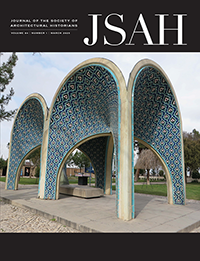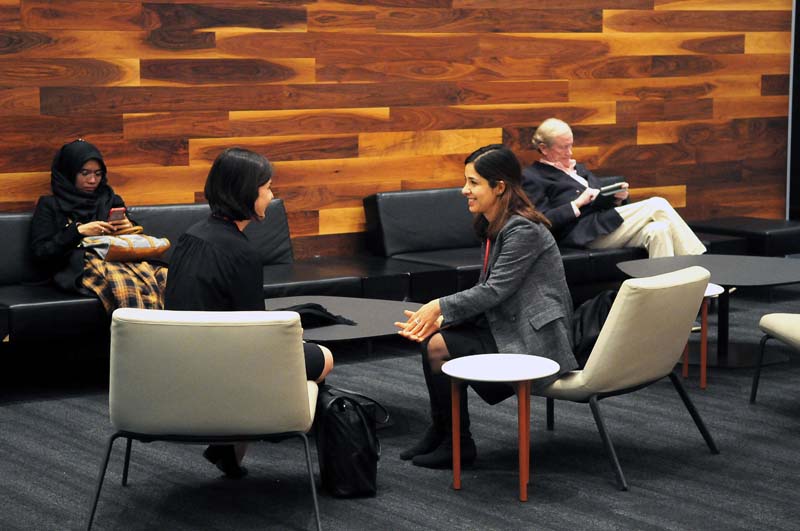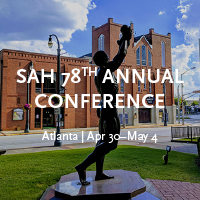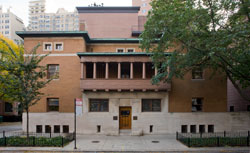-
Membership
Membership
Anyone with an interest in the history of the built environment is welcome to join the Society of Architectural Historians -
Conferences
Conferences
SAH Annual International Conferences bring members together for scholarly exchange and networking -
Publications
Publications
Through print and digital publications, SAH documents the history of the built environment and disseminates scholarshipLatest Issue:

-
Programs
Programs
SAH promotes meaningful engagement with the history of the built environment through its programsMember Programs
-
Jobs & Opportunities
Jobs & Opportunities
SAH provides resources, fellowships, and grants to help further your career and professional life -
Support
Support
We invite you to support the educational mission of SAH by making a gift, becoming a member, or volunteering -
About
About
SAH promotes the study, interpretation, and conservation of the built environment worldwide for the benefit of all
Membership grants you access to exclusive resources and programs and provides support for new research and programs. Compare benefits across all our membership levels and choose the membership level that works for you.
Every Member Receives
- A yearlong subscription to the Journal of the Society of Architectural Historians (JSAH). Choose from digital access only or a combined print and digital subscription.
- On-demand access to the complete JSAH Archive (1941–present)
- Member rates for registration to SAH’s Annual International Conference
- AIA CES credits earned through conferences and study tours
- Eligibility to apply for SAH grants and fellowships
- Access to members-only lectures, virtual meetups, and more
- Connection to peers through 12 topic-focused SAH Affiliate Groups
- Access to more than 200,000 images of the built environment through the SAHARA database
- Access to SAH Commons online scholarly network
- Discount of 50% on JSTOR access with JPASS
- Eligibility to serve on the SAH Board or committees
- Subscription to the SAH Newsletter and Opportunities Weekly Roundup
Membership Levels
SAH Member
Our most popular membership tier offers optimized pricing to help everyone participate affordably in our community. Emerging scholars can apply for a one-year membership grant that helps bridge the gap between the Society's subsidized student memberships and full-cost SAH memberships.
| Rate | Description | Price: Digital | Price: Digital + Print |
| Individual | 12-month benefits for one person | $163 | $173 |
| Joint | 12-month benefits for two people (domestic partners). Each person receives a unique member ID and their own login to the member portal. | $233 | $243 |
| Retired/Emeritus | Discounted individual membership for former professionals on a fixed income | $98 | $108 |
| Reduced | Discounted individual membership for people working independently or at an institution without full-time employment. This includes adjunct and contingent faculty unemployed workers. | $98 | $108 |
| Student | Discounted individual membership for students currently enrolled in an undergraduate or graduate program in architectural history or related disciplines. | $60 | $70 |
| Professional Associate | Discounted individual memberships for groups of professionals working in the same museum, office, or firm. Ideal for architects, research or preservation groups, museum staff, and public design education. | $179 for first member + $103 for each additional member at the same institution | |
Upper-Level Member
Show your support for SAH’s mission by including a tax-deductible donation along with your Individual or Joint print + digital membership. Upper-level members receive all the benefits of a regular membership plus:
- Discount on registration for SAH Annual Conference, rates given below.
- Acknowledgement in four quarterly issues of JSAH, the annual report, and quarterly donor reports
- Membership to Frank Lloyd Wright National Reciprocal Sites Program, with which our headquarters, the Charnley-Persky House is affiliated.
- Early registration access for SAH Study and Excursion tours
| Tier | Donation | Price with Individual Membership | Price with Joint Membership | Discount on Annual Conference Registration |
| Cornerstone | $150 | $323 | $393 | 5% |
| Pillar | $350 | $523 | $593 | 7% |
| Keystone | $500 | $673 | $743 | 8% |
Life and Benefactor Member
Show your long-term commitment to SAH by becoming a Life member. Life members’ dues provide unrestricted funds to support the Society’s mission and continued opportunities for all members. Lock in your price and enjoy the most comprehensive suite of member benefits without the need to renew each year.
Life members receive these additional benefits:
- Acknowledgement in JSAH, annual report, and quarterly donor reports
- Membership to Frank Lloyd Wright National Reciprocal Sites Program, with which our headquarters, the Charnley-Persky House is affiliated.
- Early registration access for SAH Study and Excursion tours
- Specialty membership card
- Free tour of SAH's historic headquarters at the Charnley-Persky House in Chicago, IL
- One complimentary walking tour during SAH Annual Conference, reserved in advance, on a space-available basis.
- Free copy of an SAH Buildings of the United States book of your choice
Current Life Members can enhance their commitment to SAH by becoming a Benefactor through a $5,000 tax-deductible donation.
| Tier | Price | Donation Total |
| Life | $5,000 (one payment or four annual payments of $1,250) | None * |
| Benefactor | $10,000 | $5,000 |
* Life memberships are amortized over a period of 20 years and pay for annual benefits. There is no tax-deductible portion associated with Life membership.
President's Circle
SAH is immensely grateful to the many Life and Benefactor Members who continue to support the Society financially year after year. President’s Circle status recognizes the ongoing commitment these members show.
President’s Circle status is an annual distinction given to all Life and Benefactor members who make gifts to the Society of Architectural Historians totaling $1,000 or more during a given 12-month period. The status is applied to a donor as soon as they have achieved $1,000 in gifts within a single calendar year. The status is valid for 12 months from that date, and the date shall serve as an anniversary by which to renew their President's Circle status with one or more gifts totaling $1,000.
President's Circle members receive special benefits as thanks for their support:
- 10% discount on member-rate conference registration
- Recognition from the podium at SAH Celebrates annual gala
Limited-Access Affiliate
Affiliate membership permits an individual to participate in the activities of one or more SAH Affiliate Groups and the SAH Commons online scholarly network, without access to any other SAH benefits such as JSAH or discounted registration for conferences. Price is $25 per year.
Institutional Subscription
Institutional membership provides a subscription to JSAH and/or JSAH Online for communities of readers at public and academic libraries, museums, schools of architecture, architectural history departments, and other large institutions. Institutional subscribers receive the SAH Newsletter, qualify for discounted Career Center job ads, and member-rate registration for two library staff attending the SAH Annual International Conference.
The University of California Press handles institutional subscriptions on SAH's behalf. Visit the UC Press website to join or renew your Institutional subscription.
| Subscription Type | Price per Year | Additional Benefits |
|---|---|---|
| Digital Only | $693 | |
| Print + Digital - Domestic | $781 | |
| Print + Digital - International | $807 | |
| Sustaining | $881 |
|
Affiliate Groups
SAH Affiliate Groups are comprised of SAH members who share a common, narrowly defined interest, scholarly or otherwise. Participation in Affiliate Group activities is a benefit of SAH membership.
SAH Chapters
SAH has chapters located across the United States. Chapters are independently run organizations that are affiliated with SAH. SAH members can join chapters in their region.
Member Stories
Member Stories: Bridget Maley
Feb 3, 2022
by
SAH News

Bridget Maley is the owner of architecture + history (a + h), an architectural history and historic preservation consulting firm. She lives in San Francisco, California, and has been a member of SAH since 1995.
Can you tell us about your career path?
I started my career in historical archaeology at Old Salem, in Winston-Salem, North Carolina then at Monticello and Poplar Forest, both sites affiliated with Thomas Jefferson in Virginia. I received a master’s degree in Architectural History from the School of Architecture at the University of Virginia (UVa). I benefited from an incredible network of academic and professional mentors while at UVa and after! I moved to San Francisco, California, and began working for an architectural firm specializing in historic preservation, Architectural Resources Group (ARG), as their first in-house architectural historian. I helped ARG grow a historic resources and architectural history studio, at one point managing seven architectural historians in two offices. My time at ARG taught me that you can manage a business while doing the work that you love. I started my own practice ten years ago and I love the flexibility of working for myself!
What interests you most about architectural history?
I think it’s the stories that buildings and sites tell us; they provide a tangible, visible reminder of our past. I particularly enjoy the research component…finding that one piece of information that completes the puzzle and really informs how we interpret a particular historic place.
What projects are you currently working on?
The past three years, I’ve had a significant focus on National Park Service (NPS) projects. I’ve participated in several Historic Structure Reports (HSR) on Mission 66-era NPS Visitor Centers in California and Alaska. I’m working on a project in Mount Rainier National Park looking at historic resources from both the NPS Rustic Architecture period and the Mission 66 era at Ohanapechosh Campground. I also have a project at Tule Lake, a component of the World War II Valor in the Pacific National Monument, documenting several of the only remaining built resources from the Tule Lake Segregation Center. I’m participating in an HSR for two employee cabins at Lassen Volcanic National Park. Lastly, I’ve contributed recently to a Maintenance Plan for the Glacier Bay Lodge in Alaska, one of the few Mission 66-era lodges built in the National Park system and am documenting 1960s Pan Abode-constructed (kit) cabins in Alaska’s Katmai National Park, that are threatened by some very large bears who like to gnaw and scratch on their wood components!
Additionally, I’ve had several projects at the University of California, Santa Cruz, one of the most significant collections of modern campus buildings in California. Lastly, I am currently leading a team of historians writing a National Register of Historic Places Historic District Nomination for St. Francis Wood, a designed residence park with over 550 homes in San Francisco, laid out by the Olmsted Brothers. On a more personal level, I’ve been researching the California architect, John Carl Warnecke, with the intent to publish something…at some point…in my free time!!
Do you have a particular memory of when you first became aware of the significance of architecture or when you knew you wanted to study it?
As an undergraduate, I attended Salem College in Winston-Salem, North Carolina. The college is set within Old Salem, a preserved historic Moravian village set in a surrounding urban environment. Old Salem is a collection of historic sites, gardens, and buildings open to the public with extensive interpretive programs, including working trades people demonstrating various craft practices. Within my first year of college, I began to understand the importance of place and history through experiences at Old Salem. The summer after my sophomore year I participated in an archaeological excavation of the tannery site in Salem. This opened my eyes to how historical research and informed field investigations intersect to shape the stories we tell at historic sites.
Who has influenced your work or career?
There have been several key individuals who served as wonderful mentors throughout my career. First, Michael Hammond, my undergraduate Anthropology / Archaeology professor and the Archaeologist for Old Salem. William Kelso, historical archaeologist, who I worked with at both of Thomas Jefferson’s homes, Monticello and Poplar Forest. Drake Patten, who managed the archaeological laboratory at Poplar Forest. Richard Guy Wilson and Barbara Burlison Mooney, who I studied with at UVa. J. Murray Howard, the former Architect for Historic Buildings and Grounds at UVa, who I had the great fortune to work with for a summer. Bruce Judd and Stephen Farneth, founding Principals of Architectural Resources Group (ARG); Nina Pascale, Marketing Director at ARG; and really all the amazing colleagues I worked with over 16 years at ARG. Lastly, San Francisco Architectural Historian, Anne Bloomfield, who died way too young, and who took me under her wing when I first moved to San Francisco.
What is your biggest professional challenge?
Time management!! As a sole practitioner you do the field work, conduct historical research, write reports, correspond with clients, generate invoices, pay incoming invoices, manage subconsultants, and solve IT problems. Whew!! I don’t have time for time management!!
When and how did you become involved with SAH?
I joined SAH as a graduate student at the University of Virginia where the Thomas Jefferson Chapter was founded and continues to be very active. I served as president of the chapter for the 1992–93 academic year. When I moved to San Francisco I joined the Northern California Chapter of SAH and wrote and produced the newsletter for a few years and also served as chapter president for a period. My first SAH conference was Seattle (1995) where I gave a “Work in Progress” talk in a focused session for graduate students and emerging scholars. I served as the national SAH Chapter Liaison from 2004 to 2011. I’ve stayed active in SAH helping organize the Pasadena conference in 2009, participating on a book award committee one year, and most recently serving on the SAH CONNECTS Advisory Committee.
Do you have a vision for how SAH should evolve in the future?
It has been very rewarding to see SAH embrace the digital humanities, encourage a more diverse membership through targeted outreach, and actively engage a broader audience. These initiatives indicate a leadership and membership committed to staying relevant in a changing academic, research, and publication landscape. I think if SAH continues to evolve within an academic and scholar-focused environment the organization will be poised to remain a leader in the humanities.
What advice would you give to someone who wants to enter your field?
Network, network, network. This is a small field and it's critical to meet others with similar interests and career paths. Most of us are more than happy to mentor a younger generation because we benefited from interaction with excellent mentors ourselves.
SAH members engage with the history of the built environment through a broad array of specializations, professional fields, and areas of interest. Member Stories is a regular feature that recognizes the expertise and unique experiences of our members.

Membership Grants
Emerging scholars can apply for a one-year membership grant that helps bridge the gap between the Society's subsidized student memberships and full-cost SAH memberships.

